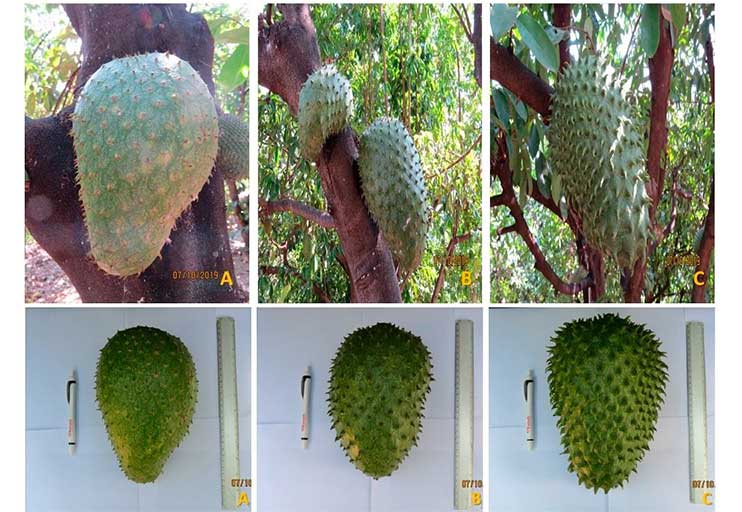Guanay-1, Guanay-2 and Guanay-3: new varieties of soursop for Nayarit
DOI:
https://doi.org/10.29312/remexca.v14i4.3098Keywords:
Annona muricata L., morphology, selection, varietiesAbstract
In Nayarit, soursop is propagated sexually, so its fruits have a variable morphology, shape and size, this has allowed the selection and evaluation of materials that have advantages compared to other genotypes of the same species and that contribute to genetic improvement. Its fruits are rich in fiber, minerals and bioactive compounds. The objective of this contribution is to disseminate the morphological and physicochemical characteristics of three new varieties of soursop Guanay-1, Guanay-2 and Guanay-3. The study was conducted in 2016-2018, trees that were ungrafted, vigorous and free of pests and diseases (19 years old) were selected, morphological and physicochemical characteristics of fruits at maturity of consumption were evaluated. The fruits of Guanay-1: were heart-shaped, length of 17.09 cm, average weight of 1 438.79 g and 86 seeds on average, the stylar protuberances measured 0.5 mm in length; in Guanay-2: the shape of the fruit was irregular, length of 25.31 cm, average weight of 1 948.1 g and 166 seeds, the stylar protuberances measured 2.05 mm in length; in Guanay-3: the shape of the fruit was conical, with length of 21.17 cm, average weight of 902.27 g and 231 seeds, stylar protuberances of 7.56 mm in length. The firmness and titratable acidity of Guanay-1 was 24.6 N and 0.6% respectively, Guanay-2 and Guanay-3 registered a firmness of 8 N and acidity of 0.9%. In conclusion, morphological characteristics were the basis for the selection and registration of these varieties that contribute to the technological development of soursop cultivation in Nayarit.
Downloads
References
AOAC. 2005. 18th Ed. Gaithersburg, Maryland, USA. 918 p.
Hernández, L. M. F.; Nolasco, G. Y. y Cruz, G. E. J. 2017. Selección y caracterización de guanábana y recomendaciones para su manejo agronómico. INIFAP-Campo Experimental Santiago Ixcuintla, Nayarit. México. Folleto técnico núm. 34. 57 p.
Hernández-Fuentes, L. M.; Nolasco-González, Y.; Santos, M. O. y Montalvo-González, E. 2021. Toxicidad de insecticidas contra (Optatus palmaris Pascoe) en guanábana. Rev. Mex. Cienc. Agríc. 12(1):49-60. https://doi.org/10.29312/remexca.v12i1.2417. DOI: https://doi.org/10.29312/remexca.v12i1.2417
Jiménez, V. M.; Gruschwitz, M.; Schweiggert, R. M.; Carle, R. and Esquivel, P. 2014. Identification of phenolic compounds in soursop (Annona muricata L.) pulp by high-performance liquid chromatography with diode array and electrospray ionization mass spectrometric detection. Food Res. Inter. 65(Part A):42-46. https://doi.org/10.1016/j. foodres.2014.05.051. DOI: https://doi.org/10.1016/j.foodres.2014.05.051
Jiménez-Zurita, J. O.; Balois-Morales, R.; Alia-Tejacal, I.; Juárez-López, P.; Sumaya-Martínez, M. T. y Bello-Lara, J. E. 2016. Caracterización de frutos de guanábana (Annona muricata L.) en Tepic, Nayarit, México. Rev. Mex. Cienc. Agríc. 7(6):1261-1270. DOI: https://doi.org/10.29312/remexca.v7i6.175
Lawrence, J. 2007. Postharvest handling of soursop. Tropical fruits newsletter. 49. Instituto Interamericano de Cooperación para la Agricultura (IICA). 16-17 pp. www.iica.org/ TropicalFruits-49postharvestsoursop.pdf.
Nolasco-González, Y.; Hernández-Fuentes, L. M. y Montalvo-González, E. 2019. Caracterización morfológica y fisicoquímica de frutos de accesiones de guanábanas seleccionadas en Nayarit. Rev. Mex. Cienc. Agríc. 23:223-237. https://doi.org/10.29312/remexca. v0i23.2023.
Nugraha, A. S.; Haritakun, R.; Lambert, J. M.; Dillon, C. T. and Keller, P. A. 2019. Alkaloids from the root of Indonesian Annona muricata L. Natural Product Research. 35(3):1-9. https://doi.org/10.1080/14786419.2019.1638380.
SIAP. 2019. Servicio de Información Agroalimentaria y Pesquera. Cierre de la producción agrícola. http://www.siap.gob.mx/cierre-de-la-produccion-agricola-por-cultivo/.
Terán-Erazo, B.; Alia-Tejacal, I.; Balois-Morales, R.; Juárez-López, P.; López-Guzmán, G.; Pérez-Arias, G. y Núñez-Colín, C. 2019. Caracterización física, química y morfológica de frutos de guanábana (Annona muricata L.). 53(7):1013-1027.
UPOV. 2019. Unión Internacional para la Protección de Obtenciones Vegetales. https://www.upov. int/test-guidelines/es/list.jsp.
Villarreal-Fuentes, J. M.; Alia-Tejacal, I.; Hernández-Salvador, M. A.; Hernández-Ortiz, E.; Marroquín-Agreda, F. J.; Núñez-Colín, C. A. and Campos-Rojas, E. 2020. In situ characterization of soursop (Annona muricata L.) in the Soconusco región, Chiapas, México. Rev. Chapingo Ser. Hortic. 26(3):189-205. https://doi.org/10.5154/r.rchsh.2020.05.008.

Published
How to Cite
Issue
Section
License
Copyright (c) 2023 Revista Mexicana de Ciencias Agrícolas

This work is licensed under a Creative Commons Attribution-NonCommercial 4.0 International License.
The authors who publish in Revista Mexicana de Ciencias Agrícolas accept the following conditions:
In accordance with copyright laws, Revista Mexicana de Ciencias Agrícolas recognizes and respects the authors’ moral right and ownership of property rights which will be transferred to the journal for dissemination in open access. Invariably, all the authors have to sign a letter of transfer of property rights and of originality of the article to Instituto Nacional de Investigaciones Forestales, Agrícolas y Pecuarias (INIFAP) [National Institute of Forestry, Agricultural and Livestock Research]. The author(s) must pay a fee for the reception of articles before proceeding to editorial review.
All the texts published by Revista Mexicana de Ciencias Agrícolas —with no exception— are distributed under a Creative Commons License Attribution-NonCommercial 4.0 International (CC BY-NC 4.0), which allows third parties to use the publication as long as the work’s authorship and its first publication in this journal are mentioned.
The author(s) can enter into independent and additional contractual agreements for the nonexclusive distribution of the version of the article published in Revista Mexicana de Ciencias Agrícolas (for example include it into an institutional repository or publish it in a book) as long as it is clearly and explicitly indicated that the work was published for the first time in Revista Mexicana de Ciencias Agrícolas.
For all the above, the authors shall send the Letter-transfer of Property Rights for the first publication duly filled in and signed by the author(s). This form must be sent as a PDF file to: revista_atm@yahoo.com.mx; cienciasagricola@inifap.gob.mx; remexca2017@gmail.
This work is licensed under a Creative Commons Attribution-Noncommercial 4.0 International license.


